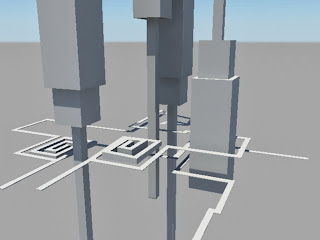'Journey' is a beautiful game, the environment is relatively low poly and nicely stylised, the textures are quite simple, but the composition of each scene is fairly close to perfect from the positioning of 3d models and the colour schemes chosen and finally the use of level design to best show off environments, the lighting changes in every level and is always excellent conveying new feelings in the player, this is complimented by the changing music that always seems to capture the mood extremely well.
'Fez' has a really interesting visual style, it is almost completely unique in that it combines a 2D platformer with a 3D world allowing the player to jump to very far away objects very easily depending on his perspective, in this sense it is an excellent game it did something very different and combined the two styles very well although the character is 2d he feels very much part of that world, the 3d models are for the most part quite blocky, simple and modular, but have a certain stylised look that is completed by the wonderful variation of textures. although fez is very good and very interesting but as soon as the player has traversed the first few worlds it starts to get alittle confusing and level designs start to look less and less original.
'Antichamber' brings puzzle games to a new level, and is incredibly fun and rewarding, yet has a very simple visual style, similar in a way to 'portal' but with much less detail, again the game is largely formed from blocks with the exceptions of some modular pieces linked to puzzles and some very abstract shapes to create a more interesting player environment. the colours only exist in the form of light, force fields, and coloured blocks that they player can fire, everything else is white with a black outline, there are a few more detailed pieces like the players gun and certain puzzles but detail is not important when maintaining a minimilast, clean visual style, and the lights do more than enough to direct the player and colour the environment.
I have also started to become interested in deconstructivism as an architectural movement because of the non-rectangular abstract shapes that are reminiscent of faceted 3D or rather faceted 3D is reminiscent of deconstructivism, this also led me to looking at deconstructionism in art, I have only started exploring this subject area but I feel it could be very relevant.
Terrapeople.ru. 2013. Untitled. [online] Available at: http://terrapeople.ru/terrapedia/wp-content/uploads/2013/02/6.jpeg [Accessed: 27 Nov 2013].
Photobucket. 2013. miloe88's image. [online] Available at: http://i581.photobucket.com/albums/ss254/miloe88/Malaysia-Singapore/IMG_9032.jpg [Accessed: 27 Nov 2013].
Michaeljamescasey.com. 2013. Untitled. [online] Available at: http://michaeljamescasey.com/blog/wp-content/uploads/2011/07/zaha1.jpg [Accessed: 27 Nov 2013].
























































